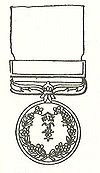Medals of Honor (Japan)
Medals of Honor (褒章, hōshō) are a decoration by the Government of Japan. They are awarded to individuals for achievements in various fields,
 Medal of Honor |
The Medals of Honor were established on December 7, 1881, and were first awarded the following year. Several expansions and amendments have been made since then. The medal design for all six types are the same, bearing the words 褒章 on a gilt central disc surrounded by a silver ring of cherry blossoms on the obverse; only the colors of the ribbon differ.
The Medals of Honor are awarded twice each year, on April 29 (the birthday of the Shōwa Emperor) and November 3 (the birthday of the Meiji Emperor).
Types

Red ribbon
First awarded in 1882. Awarded to individuals who have risked their own lives to save the lives of others.
Green ribbon
First awarded in 1882. Originally awarded "to children, grandchildren, wives and servants for remarkable acts of piety; and to individuals who, through their diligence and perseverance while engaging in their professional activities, became public role models".
Changed social values after World War II had resulted in the conferment of this medal being suspended after 1950; since 1955 it has been replaced to some extent by the revived Medal with Yellow Ribbon (see below). However in 2003 the Medal with Green Ribbon was revived as an award to morally remarkable individuals who have actively taken part in serving the society.
Yellow ribbon
First awarded in 1887 (later abolished); revived in 1955. Awarded to individuals who, through their diligence and perseverance while engaging in their professional activities, became public role models.
Purple ribbon
First awarded in 1955. Awarded to individuals who have contributed to academic and artistic developments, improvements and accomplishments.
Blue ribbon
First awarded in 1882. Awarded to individuals who have made significant achievements in the areas of public welfare or public service.
Dark blue ribbon
First awarded in 1919. Awarded to individuals who have made exceptionally generous financial contributions for the well being of the public.
Select recipients
Red
Green
Yellow
Purple
- Kamajiro Eda[5]
- Toshiko Akiyoshi[6]
- Hitoshi Narita.[7]
- Morihei Ueshiba.[8]
- Mitsuo Tsukahara.[9]
- Tsuyoshi Tsutsumi.[9]
- Miyuki Nakajima.[9]
- Eiichi Nakamura.[9]
- Joe Hisaishi.[9][10]
- Akinori Yonezawa.[9]
- Yoshihisa Yamamoto [11][12]
- Jun'ichi Tsujii
- Shigeo Hirose
- Yoshio Harada
- Toshirō Mifune
- Kiyokazu Washida
- Moto Hagio
Blue
- Yasuhiro Fukushima.[9]
- Masaru Ibuka.[13]
- Kaoru Inoue [14]
- Kazuo Imai [15]
- Keiichi Ishizaka.[9]
- Norio Ohga[16]
- Hiroko Sakai.[15]
- Shoichiro Toyoda.[17]
- Yoshikazu Yahiro.[18]
- Gōgen Yamaguchi.[19]
- Magokichi Yamaoka
- Carlos Ghosn, Renault-nissan's CEO.
Dark blue
This section is empty. You can help by adding to it. (April 2011) |
Notes
- ^ Honor awarded 1923 -- National Maritime Museum (UK)
- ^ Honor awarded 2008. [1]
- ^ Honor awarded 2009 (Okayama Prefecture) --
- ^ Honor awarded 2009 (Osaka Prefecture) --
- ^ Honor awarded 1955
- ^ Japan Foundation - Toshiko Akiyoshi
- ^ Honor awarded 1990 -- Office of Naval Research (US): "Prince Philip, Duke of Edinburgh admits Office of Naval Research engineer to United Kingdom's Royal Academy of Engineering," Press release. November 11, 2002.
- ^ Honor conferred 1960 -- North Austin Tae Kwan Do: "Chronology of the Life of Morihei Ueshiba, Founder of Aikido."
- ^ a b c d e f g h Honor awarded 2009 (Tokyo Prefecture) --
- ^ "678 individuals, 24 groups awarded Medals of Honor," Mainichi Shimbun. November 3, 2009; "Ghibli Composer Joe Hisaishi Awarded Medal of Honour," Anime News Network. November 3, 2009.
- ^ http://news-service.stanford.edu /pr/2005/pr-purple-113005.html
- ^ http://www.nii.ac.jp/brief/hyosho/hyosho-20051102-e.html
- ^ Honor awarded 1960 -- Sony Corporation: [2].
- ^ Honor awarded 2009 (Nagasaki Prefecture) --
- ^ a b Honor awarded 2009 (Kyoto Prefecture) --
- ^ Sony, "Passing of Norio Ohga, Senior Advisor and former President and Chairman, Sony Corporation," April 23, 2011; retrieved 2011-08-08
- ^ Honor awarded 1984 -- Toyota Motor Corporation: Toyoda, Honorary Chairman.
- ^ Honor awarded 2009 (Fukuoka Prefecture) --
- ^ Gōjū Kai web site
References
- Peterson, James W., Barry C. Weaver and Michael A. Quigley. (2001). Orders and Medals of Japan and Associated States. San Ramon, California: Orders and Medals Society of America. ISBN 1-890974-09-9
External links
- Japan, Cabinet Office: Decorations and Medals
- Decoration Bureau: Medals of Honour
- Japan Mint: Production Process







